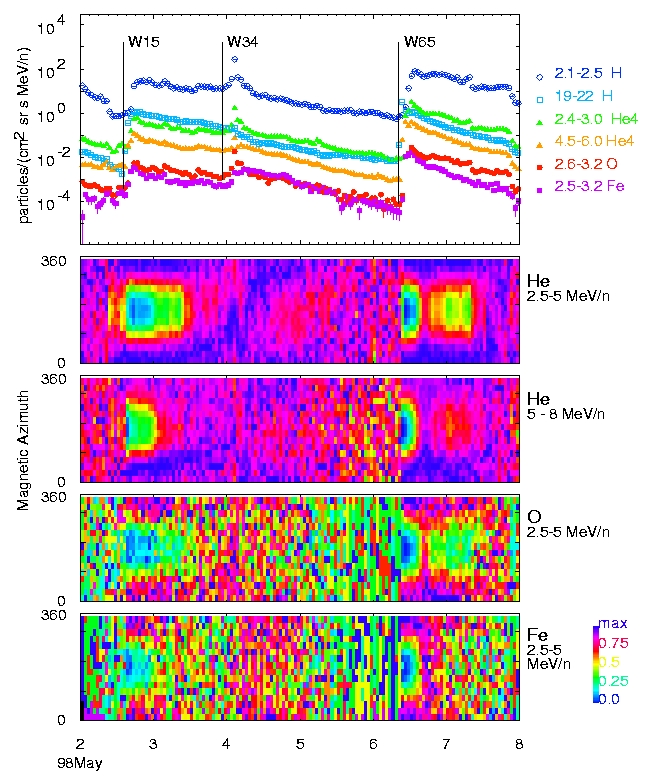The Energetic Particles: Acceleration, Composition and Transport
Investigation
on the Wind Spacecraft
SUMMARYThe Energetic Particles: Acceleration,
Composition and Transport (EPACT) investigation is designed to make
comprehensive observations of solar, interplanetary, and galactic particles over
wide ranges of charge, mass, and intensity using a combination of 8 different
particle telescopes.
Energetic particles are electrons or ions of all the chemical elements that
have been accelerated to speeds of one tenth of the speed of light
or more. These particles are accelerated in solar flares and at
shock waves driven out from the Sun by fast coronal mass ejections
(CMEs). They are accelerated in planetary magnetospheres and
bow shocks and at the heliospheric termination shock
where the solar wind runs into interstellar material (these latter particles are
called anomalous cosmic
rays (ACRs). The galactic cosmic rays
(GCRs) are accelerated by shock waves from distant supernovae.
We can observe particles from all these sources in the near-Earth
environment. By measuring the energy spectra and element abundances of the
energetic particles, and their variation with time, we can distinguish all these
sources and study the physics of particle acceleration on a
broad scale.
When energetic particles interact with matter or magnetic fields, they
generate photons in the form of X-rays, gamma rays, and radio emission. We can
see these photons from the distant parts of our galaxy and beyond, but we cannot
see the energetic particles that produce them. Thus, our own heliosphere serves
as a local laboratory where we can study the fundamental physics of the
energetic processes that occur throughout the cosmos.
Electrons are measured from 0.2 to 10 MeV, primarily providing time markers
for injections of solar particles. Hydrogen is measured from 1.4 to 120 MeV, and
Helium is measured from 0.04 to 500 MeV/nucleon. The collection powers and
energy ranges for heavier nuclei up to iron are ideal for observations of
quiet-time populations such as particles accelerated by interplanetary shocks
and the anomalous cosmic rays. The large collecting power available is ideal for
observing 3He, 4He, and heavier nuclei in impulsive solar events. For the first
time it may be possible to observe ultra heavy nuclei (Z> 30) in large solar
events. Finally, there is also a telescope designed to measure isotopes from He
to Fe, which is intended for solar particles, anomalous cosmic rays, and
galactic cosmic rays. There will be important opportunities for combined studies
with other spacecraft, such as SAMPEX, Ulysses, and Voyagers 1 and 2.
LAUNCHThe Wind spacecraft was launched
at 04:30 EST on Nov. 1, 1994 aboard a Delta rocket. The orbit is designed to
make several passes through the magnetosphere and then move into a halo orbit
around the earth-sun L1 Lagrange point.
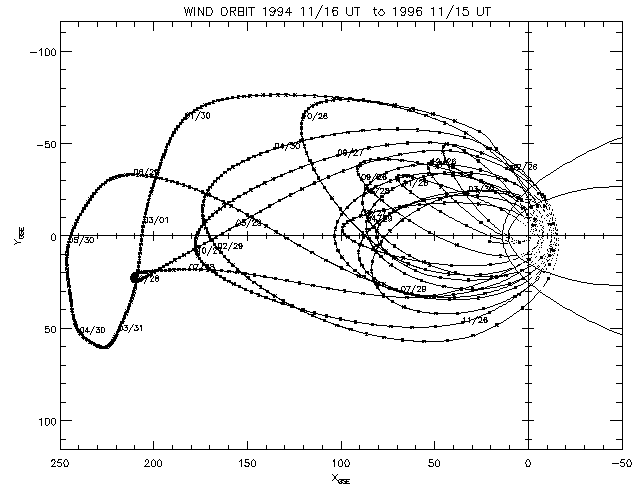
EPACT Orbit
|
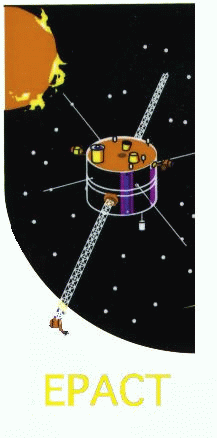
EPACT
Logo |
EPACT "FIRSTS"
- Particle detection algorithm - 64K particles per second are binned in
Energy and Charge
(Reference 2)
- Use of RAM for coincidence logic (Reference 2)
- Heavy-Ion Abundances upstream of the Earth's Bow Shock
(Ref. 7 and 42)
- Observations of anomalous Ar and S
(Refs. 9, 10, and 23)
- New Abundances and Broad Longitude Extent for CIR events
(Refs. 13, and 14)
- Observation of 3He Re-acceleration by the Bow Shock
(Ref. 16)
- Observation of Cross-field scattering in CIR events
(Ref. 17)
- Effects of Self-generated Waves on SEP Abundances
(Refs. 25, 26, 33, and 35)
- Abundances and Spectra of trans-Fe (Z=34-82) in SEP events
(Refs. 38, 40)
- Observation of Seed Population Accelerated at CIRs
(Ref. 43)
- Phase of 27day ACR modulation and the global solar magnetic field
(Ref. 52)
- First angular distributions of Fe/O and SEP trapping
(Ref. 58)
- First observation of ACRs at solar minimum
(Ref. 62)
INSTRUMENT DESCRIPTIONS
OverviewThe EPACT investigation must make
measurements over an extremely broad range of elements, energies, and
intensities. As a result, EPACT consists of multiple telescopes that also
provide a level of protection against single-point failures. The Low Energy
Matrix Telescope (LEMT) consists of three identical telescopes, whereas ELITE
consists of two Alpha-Proton-Electron (APE) telescopes and an Isotope Telescope
(IT). LEMT and ELITE have been designed, built and tested by the Low Energy
Cosmic Ray Group and the Electronics Systems Branch of the Laboratory for High
Energy Astrophycis at the NASA Goddard Space Flight Center. Later, the
Suprathremal Energetic Particle telescope system (STEP) was added to EPACT. STEP
contains two identical telescopes. STEP was designed and built by the University
of Maryland.
All the telescopes except for those in STEP use the dE/dx by E method of
particle identification. Solid-state detectors are used throughtout for
reliability and long-term stability. STEP measures time-of-flight and energy,
from which particle mass can be obtained. Each STEP telescope includes a start
and stop microchannel plate detector as well as a solid-state detector to
measure the total energy.
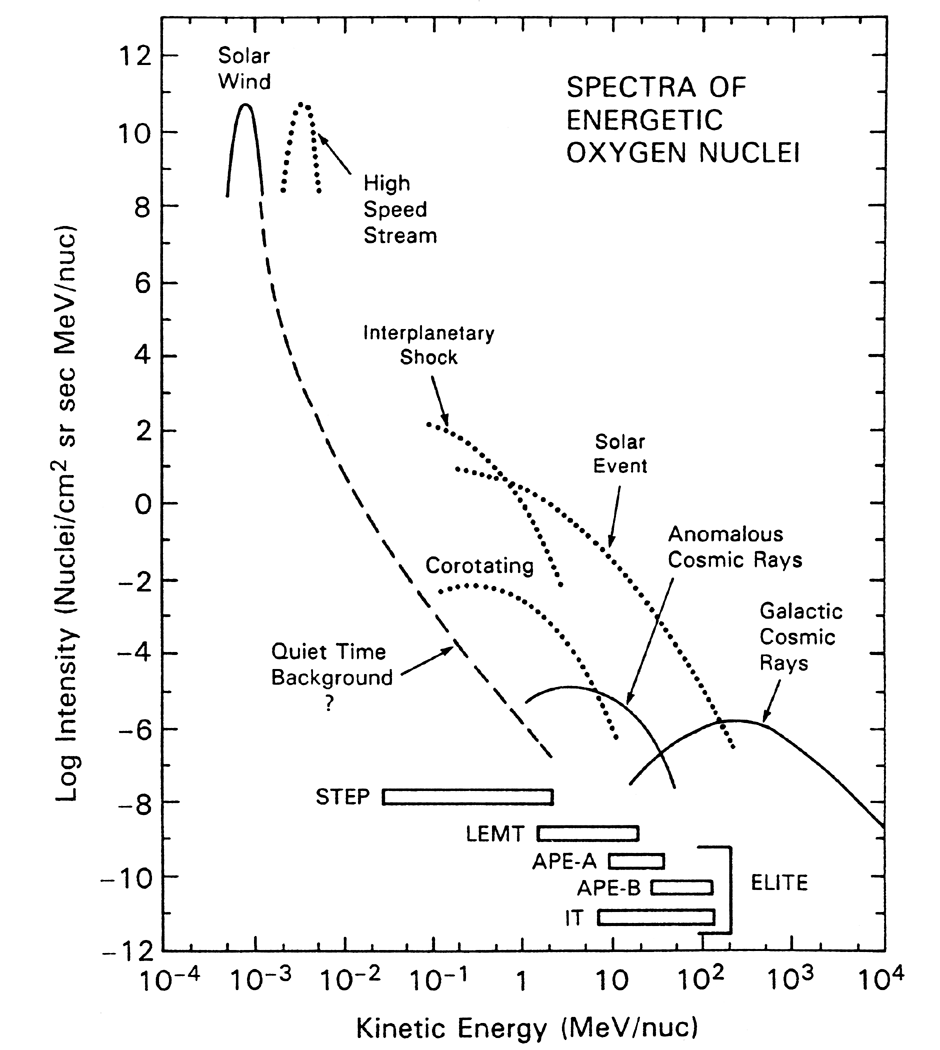 EPACT Science
Detector Subsystems
The Low Energy Matrix Telescope
(LEMT)
The front dE/dx elements are 16 surface barrier
detectors arrayed on a spherical dome in order to minimize path-length
variations. Each detector is nominally 1.75 cm2 by 18 microns thick.
The residual E detector is an ion-implanted detector 36 cm2 by 1000
microns thick. It is subdivided into five 13.3 mm wide strips on each side.
 TOP TOP
The Electron Isotope System (ELITE)
The Alpha-Proton-Electron (APE) Telescopes
The primary purpose of the APE telescopes is to provide coverage of the
lowest charge particles over a wide range of incident energies up to very high
rates. The APE telescopes do ovserve heavy nuclei up through iron, however, and
can resolve isotopes of the lighter elements without trajectory information.
APE-A consists of four detectors. The A1 and A2 detectors are
circular silicon surface barrier detectors, nominally 150 microns thick by 8
cm2. Double foils are used in front of the telescope to protect the
A1 detector from sunlight and from high counting rates due to particles at
energies just below the APE-A energy range. The A3 and A4 detectors are circular
Lithium drifted detectors (LiDs) 3 mm thick by 17 cm2. The telescope
acceptance geometry is defined by a coincidence between the A1 and A2 detectors
in anti-coincidence with the A4 detector. The geometry factor for the telescope
is 1.2 cm2 sr, independent of energy.
APE-B consists entirely of LiD detectors. The B1 and B2 detectors
are curved (radius of curvature of 7.0 cm) to minimize path length variations.
The maximum variation is 2.8 % for particles not passing through an edge of B1
or B2. Particles stopping in APE-B are identified by a coincidence condition of
B1 * B2* ~C7 (~ means NOT). The geometry factor for stopping particles is 1.3
cm2 sr. Particles stopping in B2 are referred to as 2-D particles,
while those penetrating B2 and stopping in one of C1 through C6 are referred to
as 3-D particles. Penetrating particles are also accepted for analysis. This
expands the energy range to include minimum ionizing particles. Penetrating
particles include both particles which enter through B1 and exit through D
(forward particles) and those which enter D and exit B1 (backward particles).
APE B has been mounted on a short tower with an unobstructed 180 degree view to
allow both types of particles. The geometry factor for penetrating particles is
1.95 x 1.08 cm2 sr, after allowing for 5% obstruction of the FOV by
the spacecraft.
The Isotope Telescope
This instrument consists of 8 silicon detectors. The first two detectors are
two dimensional position sensitive detectors (PSDs). They are required so that
path-length corrections may be made for the angle of incidence and for
nonuniformities in detector thickness. The electrodes on each side of each PSD
are segmented into 125 strips with a pitch of 0.5 mm and an inter-strip gap of
35 microns. The strips are interconnected by 68 ohm chip resistors at the
periphery of the detector wafer. Preamplifiers connected to strips 1, 32, 63,
94, and 125 subdivide each PSD into 4 sections of 32 strips each. From the
signal on the 5 preamplifiers, the particle position can be measured. This
technique works well for nuclei with charge Z > 2. For He, the isotopes are
well separated, even with poor spatial resolution. The next 5 detectors below
the PSDs (E1 - E5) vary in thickness from 150 microns to 8 mm. Multiple dE/dx
measurements are possible with this system.
 TOP TOP
The Suprathermal Energetic Particle System
(STEP)
Below is a picture of the STEP instrument. The protective doors provide an
extension of the sun shade at the entrance to each STEP telescope. The
measurement technique used in STEP is Time-of-flight vs Total E. In each of two
identical telescopes, incoming nuclei enter through a pair of thin nickel foils,
pass through a time-of-flight region and strike a surface barrier silicon solid
state detector located at the rear of the telescope. The detector is thick
enough to stop all particles of interest and the detector signal thus represents
the total energy of the particle. This energy signal is detected by a standard
charge-sensitive amplifier, shaped with a peaking time of 1 microsecond and run
through a pair of discriminator amplifiers and a pair of parallel linear
amplifiers of differing gain. Two amplitude discriminators set to 80 keV and 10
MeV allow us to select which of the two linear amplifier outputs to analyze. The
high gain linear amplifier generates a full scale output for an input of about
12 MeV, the low gain channel handles up to about 60 MeV.
In parallel with the energy, the time of flight is analyzed. As the incoming
ion passes through the inner nickel foil, it knocks a few secondary electrons
off the inner surface of the foil into the TOF region. These electrons are
accelerated by a 1 kV potential within the chamber and are directed toward a
chevron pair of microchannel plates (MCPs) which detects them and multiplies
them by roughly 107, producing a measurable signal. The output signal is
designated as START. A similar STOP signal is derived from the back-scattered
secondary electroncs produced when the incoming ion strikes the front surface of
the solid state detector. The time between the two signals equals the time taken
by the ion to traverse the TOF chamber and is typically 2 - 100 nsecs. The START
and STOP signals are processed through constant-fraction discriminators to
reduce "walk" and drive a time-to-amplitude converter (TAC) whose output
represents the time-of-flight of the ion. Logic circuitry is used to detect the
coincidence of a STOP signal occurring within 100 nsec of a START and signals
this coincidence by generating a VALID STOP pulse.
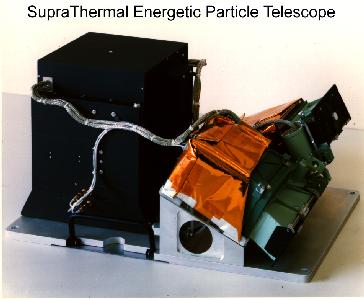
STEP Instrument
 TOP TOP

SEP Abundance Variations (Ref 25) |
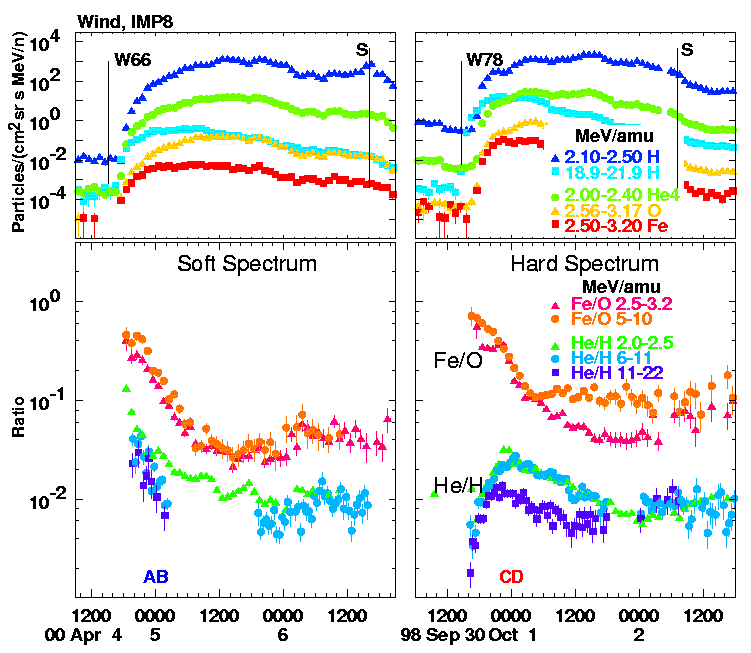
He/H in SEP Events (Ref 33) |

The July 2000 Event (Ref 40) |
Wind/EPACT-Related Refereed-Publication List
-
"Focused Interplanetary Transport of ~1 MeV Solar Energetic
Protons through Self-Generated Alfven Waves," Ng, C. K.,
and Reames, D. V., 1994, ApJ, 424, 1032.
-
"The Energetic Particles: Acceleration, Composition,
and Transport (EPACT) Experiment on the Wind Spacecraft,"
von Rosenvinge, T. T., Barbier, L. M., Karsh, J., Liberman, R.,
Madden, M. P., Nolan, T., Reames, D. V., Ryan, L., Singh, S.,
Trexel, H., Winkert, G., Mason, G. M., Hamilton, D. C., and Walpole,
P., 1995, Space Sci. Revs., 71, 155.
-
"Solar Energetic Particles: A Paradigm Shift,"; (Invited
Paper), Reames, D. V. 1995, Revs. Geophys. 33, Suppl. (U. S. National
Report to the IUGG, 1991-1994), 585.
-
"The Dark Side of the Solar Flare Myth,";, Reames,
D. V., 1995, Eos, 76, 405.
-
"Pitch Angle Diffusion Coefficient in an Extended Quasi-Linear
Theory," Ng, C. K. and Reames, D. V. 1995, ApJ, 453, 890.
-
"The Spatial Distribution of Particles Accelerated by
CME-Driven Shocks," Reames, D. V., Barbier, L. M., and Ng,
C. K. 1996, ApJ, 466, 473.
-
"Energetic heavy ions observed upstream of the Earth's bow shock by the
STEP/EPACT instrument on WIND", Mason, G. M., J. E. Mazur, and
T. T. von Rosenvinge, Geophys. Res. Letters, 23, 1231-1234, 1996..
-
"Fe-rich solar energetic particle events during solar minimum", Mazur, J. E.,
G. M. Mason, and T. T. von Rosenvinge, Geophys. Res. Letters,
23, 1219-1222, 1996
-
"WIND/EPACT Observations of Anomalous Cosmic Rays,",
Reames, D. V., Barbier, L. M., and von Rosenvinge, T. T., 1997, Adv. Space
Res., 19, No. 5, 809.
-
"First Observation of Sulphur in Anomalous Cosmic Rays by the
GEOTAIL and WIND Spacecraft," Takashima, T., Doke, T., Hayashi, T.,
Kikuchi, J., Kobayashi, M., Shirai, H., Takehana, N., Ehara, M., Yamada, Y.,
Yanagita, S., Hasebe, N., Kashiwagi, T., Kato, C., Munakata, K., Kohno, T.,
Kondoh, K., Murakami, H., Nakamoto, A., Yanagimachi, T., Reames, D. V., and
von Rosenvinge, T. T., 1997, ApJ (Letters), 477, L111.
-
"Energy Spectra of Ions Accelerated in Impulsive and Gradual Solar
Events," Reames, D.V., Barbier, L.M., von Rosenvinge. T. T., Mason, G.
M., Mazur, J. E., and Dwyer, J. R., 1997, ApJ, 483, 515.
-
"Energetic Particles and the Structure of Coronal Mass Ejections,"
Reames, D. V., 1997,in Coronal Mass Ejections, eds. N. Crooker, J. A. Jocelyn
and J. Feynman, Geophysical Monograph 99 (Amer. Geophys. Union, Washington, DC),
p 217.
-
"New Spectral and Abundance Features of Interplanetary Heavy Ions in Corotating
Interaction Regions,"
Mason, G. M., Mazur, J. E., Dwyer, J. R., Reames, D. V.,
and T. T. von Rosenvinge, 1997, ApJ Letters, 486, L149.
-
"Late-Phase Acceleration of Energetic Ions in Corotating Interaction Regions,"
Reames, D. V., Ng, C. K., Mason, G. M., Dwyer, J. R., Mazur, J. E., and von
Rosenvinge, T. T., 1997, Geophys. Res. Letters, 24, 2917.
-
"Spatial and Temporal Invariance in the Spectra of Energetic Particles in
Gradual Solar Events," Reames, D. V., Kahler, S. W., and Ng, C. K.,
1997, ApJ, 491, 414.
-
"Acceleration of solar flare 3He at the Earth's bow shock", Dwyer, J. R.,
G. M. Mason, J. E. Mazur, and T. T. von Rosenvinge, Geophys. Res.
Letters, 24, 61, 1997.
-
"Perpendicular transport of low energy corotating interaction region -
associated nuclei",; Dwyer, J. R., G. M. Mason, J. E. Mazur, J. R. Jokipii,
T. T. von Rosenvinge, and R. P. Lepping, Astrophys. J.
(Letters), 490, L115-L118, 1997.
-
"Evidence for Multiple Ejecta; April 7-11, 1997 ISTP Sun-Earth Connection
Event,"
Berdichevsky, D., et al., 1998 Geophys. Res. Letters, 25, 2473.
-
"Streaming-Limited Intensities of Solar Energetic Particles,"
Reames, D. V. and Ng, C. K., 1998, ApJ 504, 1002.
-
"Solar Energetic Particles: Sampling Coronal Abundances,"
Reames, D.V., 1998, Space Science Revs. 85, 327.
-
"Reply to the
comment by G. C. Anagnostopoulos on the paper Energetic Heavy Ion Observed
Upstream of the Earth's Bow Shock by the STEP /EPACT Instrument on WIND",
Mason, G. M., J. E. Mazur, and T. T. von Rosenvinge,
Geophys. Res. Letters, 25, 1527-1528, 1998.
-
"Solar energetic particles inside magnetic clouds observed with the Wind
spacecraft", Mazur, J. E., G. M. Mason, J. R. Dwyer, and T. T. von Rosenvinge,
Geophys. Res. Letters, 25, 2521-2524, 1998.
-
"Quiet-time Spectra and Abundances of Energetic Particles during the 1996
Solar Minimum," Reames, D. V., 1999, Astrophys. J., 518, 473.
-
"Solar Energetic Particles: Is There Time to Hide?"
Reames, D. V., 1999, Radiation Measurements 30/3, 297.
-
"Observations of Systematic Temporal Evolution in Elemental
Composition During Gradual Solar Energetic Particle Events,"
Tylka, A. J., Reames, D. V., and Ng, C. K., 1999, Geophys. Res. Letters, 26,
2141.
-
"Effect of Proton-Amplified Waves on the Evolution of Solar Energetic
Particle Composition in Gradual Events,"
Ng, C. K., Reames, D. V., and Tylka, A. J., 1999,
Geophys. Res. Letters, 26, 2145.
-
"Particle Acceleration at the Sun and in the Heliosphere,"
Reames, D. V., 1999, Space Science Revs. 90, 413.
-
"Energy -Dependent Ionization States of Shock-Accelerated Particles in
the Solar Corona,"
Reames, D. V., Ng, C. K., and Tylka, A. J., 1999, Geophys. Res. Letters,
26, 3585.
-
"Energetic particle abundances at CIR shocks", Franz, M., E. Keppler,
U. Lauth, M. K. Reuss, G. M. Mason and , J. E. Mazur, Geophys. Res.
Letters, 26, 17-20, 1999.
-
"Simultaneous observations of energetic (~150 keV) protons upstream of the
Earth's bow shock at ACE and WIND", Haggerty, D. K., M. I. Desai, G. M. Mason,
J. R. Dwyer, R. E. Gold, S. M. Krimigis, J. E. Mazur, and T. T. von Rosenvinge,
Geophys. Res. Letters, 26, 169-172, 1999.
-
"Particle acceleration and sources in the November 1997 solar energetic
particle events",
Mason, G. M, C. M. S. Cohen, A. C. Cummings, J. R. Dwyer, R. E.
Gold, S. M. Krimigis, R. A. Leske, J. E. Mazur, R. A. Mewaldt, E. Moebius,
M. Popecki, E. C. Stone, T. T. von Rosenvinge, and M. E. Wiedenbeck,
Geophys. Res. Letters, 26, 141-144, 1999.
-
"Origin, injection, and acceleration of CIR particles: observations",
Mason, G. M., R. von Steiger, R. B. Decker, M. I. Desai, J. R. Dwyer,
L. A. Fisk, G. Gloeckler, J. T. Gosling, M. Hilchenbach, R. Kallenbach, E.
Keppler, B. Klecker, H. Kunow, G. Mann, I. G. Richardson, T. R. Sanderson,
G. M. Simnett, Y.-M. Wang, R. F. Wimmer-Schweingruber, M. Franz, and J. E.
Mazur, Space Sci. Rev., 89 , 327-367 1999.
-
"Initial Time Dependence of Abundances in Solar Particle
Events," Reames, D. V., Ng, C. K., and Tylka, A. J., 2000,
Astrophys. J. Letters, 531, L83.
- "Examples of Fast Solar Wind Transients, Their Sources and the
Forecast of Possible Geomagnetic Impact,"
Berdichevsky, D., Richardson, I. G., Thompson, B. J.,
Reames, D. V., MacDowall, R., Plunkett, S. P., Michels, D. J., Kaiser, M. L.,
Lepping, R. P., Ogilvie, K. W., and Stone, R. G., 2000, Geofisica
Internacional 39, 5.
-
"The Observational Consequences of Proton-Generated Waves at
Shocks,"
Reames, D. V., 2000,
in Acceleration and Transport of
Energetic Particles Observed in the Heliosphere, eds. R.A. Mewaldt, J.R.
Jokipii, M.A. Lee, E. Moebius, and T.H. Zurbuchen, AIP Conf.
Proc. 528, p. 79.
-
"Temporal Evolution in the
Spectra of Gradual Solar Energetic Particle Events,"
Tylka, A. J., Boberg,
P. R., McGuire, R. E., Ng, C. K., and Reames, D. V., 2000,
in Acceleration and Transport of
Energetic Particles Observed in the Heliosphere, eds. R.A. Mewaldt, J.R.
Jokipii, M.A. Lee, E. Moebius, and T.H. Zurbuchen, AIP Conf.
Proc. 528, p. 147.
-
"SEPs: Space Weather Hazard in Interplanetary Space, "
Reames, D. V., 2000
Proc. Chapman Conference, Space Weather: Progress and Challenges
in Research and Applications, in press.
-
"Abundances of Trans-Iron Elements in Solar Energetic Particle Events,
"
Reames, D. V., 2000, Ap. J. Letters 540, L111
- "Solar Wind: Energetic Particles," Reames, D. V., 2001,
Encyclopedia of
Astronomy and Astrophysics, P. Murdin (ed.) (Inst. of Physics
Publ., Bristol), 4, 2829.
-
"Heavy Ion Abundances and Spectra and the Large Gradual Solar
Energetic Particle Event of 2000 July 14,"
Reames, D. V., Ng, C. K. and Tylka, A. J.
2000, ApJ Letters 548, L233.
-
"Characteristics of energetic (>30 keV/nucleon) ions observed by the WIND/STEP
instrument upstream of the Earth's bow shock",
Desai, M. I., G. M. Mason, J. R. Dwyer, J. E. Mazur, T. T. von
Rosenvinge, and R. P. Lepping, J. Geophys. Res., 105, 61-78, 2000.
-
"The spatial structure of ion events measured upstream of the Earth's bow shock
by ACE/ULEIS and WIND/STEP", Dwyer, J. R., G. M. Mason,
M. I. Desai, J. E. Mazur, and T. T. von Rosenvinge, Geophys. Res. Letters, 27,
65-68, 2000.
-
"The suprathermal seed population for corotating interaction region ions at 1
AU deduced from spectra of H+, He++ and He+ observed on Wind", Chotoo, K., N.
A. Schwadron, G. M. Mason, T. H. Zurbuchen, G. Gloeckler, A. Posner, L. A.
Fisk, A. B. Galvin, D. C. Hamilton, and M. R. Collier, J. Geophys.
Res., 105, 23,107-23,122, 2000.
-
"What We Don't Understand about Ion Acceleration in Flares,"
Reames, D. V.,
2000, High Energy Solar Physics: Anticipating HESSI, Eds. R. Ramaty and N.
Mandzhavidze,ASP Conference Series 206, 102.
-
"Effect of Wave Generation on the Evolution of Elemental Abundances
of Solar Energetic Particles,"
Ng, C. K., Reames, D. V., and Tylka, A. J.,
2000, High Energy Solar Physics: Anticipating HESSI, Eds. R. Ramaty and N.
Mandzhavidze,ASP Conference Series 206, 162.
-
"A Role for Ambient Energetic Particle Intensities in Shock Acceleration
of Solar Energetic Particles,"
Kahler, S. W., Reames, D. V., and Burkpile, J. T.,
2000, High Energy Solar Physics: Anticipating HESSI, Eds. R. Ramaty and N.
Mandzhavidze,ASP Conference Series 206, 468.
-
"SEPs: Space Weather Hazard in Interplanetary Space, "
Reames, D. V., 2001, in Space Weather
eds. P. Song, H. J. Singer, and G. Siscoe, Geophysical Monograph 125
(AGU, Washington, DC) p 101.
-
"Angular Distributions of Solar Energetic Particles "
Reames, D. V., Ng, C. K., and Berdichevsky, D. 2001, Ap. J. 550, 1064.
-
"Evidence for Remnant Flare Suprathermals in the Source Population of
Solar Energetic Particles in the 2000 Bastile Day Event,"
Tylka, A. J., Cohen, C. M. S.,
Dietrich, W. F., Maclennan, C. G., McGuire, R. E., Ng. C. K., and
Reames, D. V. 2001, ApJ (Letters) 558, L59.
-
"Energetic Particle Composition," Reames, D. V. 2001,
in Solar and Galactic Composition, ed. R. F. Wimmer-Schweingruber,
AIP Conf. Proc. 598, 153.
-
"Coronal Mass Ejections Associated with Impulsive Solar Energetic
Particle Events,"
Kahler, S. W., Reames, D. V., and Sheeley, N. R., Jr. 2001, ApJ 562, 558.
-
"On the Phase of the 27-Day Modulation of Anomalous and Galactic Cosmic
Rays at 1 AU during Solar Minimum,"
Reames, D. V., and Ng, C. K. 2001, ApJ (Letters) 563, L179.
-
"The Bastille Day Magnetic Clouds and Upstream Shocks: Near Earth
Interplanetary Observations,"
Lepping, R. P. Berdichevsky, D. B., Burlaga, L. F.,
Lazarus, A. J., Kasper, J., Desch, M.,D., Wu, C.-C., Reames, D. V.,
Singer, H. J., Smith, C. W., and Ackerson, K. L. 2001, Solar Physics 204,
287.
-
"Magnetic Topology of Impulsive and Gradual Solar Energetic Particle
Events,"
Reames, D. V. 2002, ApJ (Letters) 571, L63.
-
"Interacting Coronal Mass Ejections and Solar Energetic Particles,"
Gopalswamy, N., Yashiro, S., Michalek, G., Kaiser, M. L., Howard, R. A.,
Reames, D. V., Leske, R., and von Rosenvinge, T. 2002, ApJ (Letters) 572, L103.
-
"Energetic Particle Abundances as Probes of an Interplanetary Shock Wave,
"
Reames, D. V., and Tylka, A. J. 2002, ApJ (Letters), 575, L37.
-
"The Relative Recovery of Galactic and Anomalous Cosmic Rays at 1 AU:
Further Evidence for Modulation in the Heliosheath,"
McDonald, F. B., Klecker, B.,
McGuire, R. E., and Reames, D. V. 2001, JGR 107, NO. A8,
10.1029/2001JA000206
-
"Angular Distributions of Fe/O from Wind: New Insights into SEP Transport,
"
Reames, D. V., and Ng, C. K. 2002 ApJ (Letters) 577, L59.
-
"Flare- and Shock-Accelerated Energetic Particles in the Solar Events
of 2001 April 14 and 15," Tylka, A. J., Boberg, P. R., Cohen, C. M. S.,
Dietrich, W. F., MacLennan, C. G., Mason, G. M., Ng, C. K., and
Reames, D. V. 2002, ApJ (Letters) 581, L119.
-
"Halo-Coronal Mass Ejections near the 23rd Solar Minimum: Lift-off,
Inner Heliosphere, and in Situ Signatures,"
Berdichevsky, D. B., Farrugia, C. J., Thompson, B. J., Lepping, R. P.,
Reames, D. V, Kaiser, M. L., Steinberg, J. T., Plunkett, S. P., and Michels,
D. J. 2002, Annales Geophysicae 20, 891.
-
"Solar Energetic Particle Production by CME-Driven Shocks in Solar
Fast-Wind Regions,"
Kahler, S. W. and Reames, D. V. 2003, ApJ 584, 1063.
-
"
Wind Observations of Anomalous Cosmic Rays from Solar Minimum to Maximum,
"
Reames, D. V. and F. B. McDonald 2003, Astrophys. J. (Letters) 586, L99.
-
"Modeling Shock-Accelerated Solar Energetic Particles Coupled To
Interplanetary Alfven Waves,"
Ng, C. K., Reames, D. V., and Tylka, A. J, 2003,
ApJ 591, 461.
-
"Effect of CME Interactions on the Production of Solar Energetic
Particles,"
Gopalswamy, N., Yashiro, S., Michalek, G., Kaiser, M. L., Howard, R. A.,
Leske, R., von Rosenvinge, T., and Reames, D. V.,
2003, Solar Wind Ten (Pisa, Italy), Eds. M. Velli, R. Bruno, and F. Malara
AIP Conf. Series 679, 608.
-
"Solar-Heliospheric-Magnetospheric Observations on March 23- April 26,
2001: Similarities to Observations in April 1979,"
Berdichevsky, D. B., Farrugia, C. J., Lepping, R. P., Richardson, I. G.,
Galvin, A. B., Schwenn, R., Reames, D. V., Ogilvie, K. W., and Kaiser, M. L.,
2003, Solar Wind Ten (Pisa, Italy), Eds. M. Velli, R. Bruno, and F. Malara
AIP Conf. Series 679, 758.
-
"Solar Energetic Particle Variations"
Reames, D. V. 2004, Adv. Space Res., in press.
-
"Coronal Shocks and Solar Energetic Particles,"
Cliver, E. W., Kahler, S. W., and Reames, D. V. 2004
ApJ, in press.
-
"Heavy-Element Abundances in Solar Energetic Particle Events,"
Reames, D. V., and Ng, C. K. 2004
ApJ, in press.
|

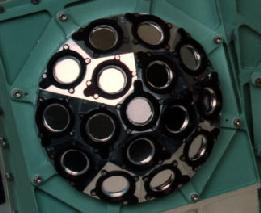
 TOP
TOP
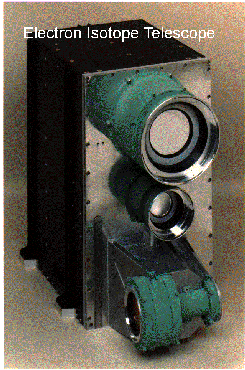
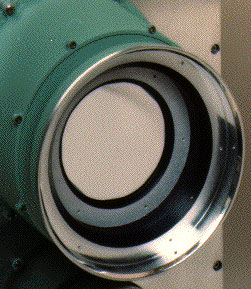
 TOP
TOP

 TOP
TOP


